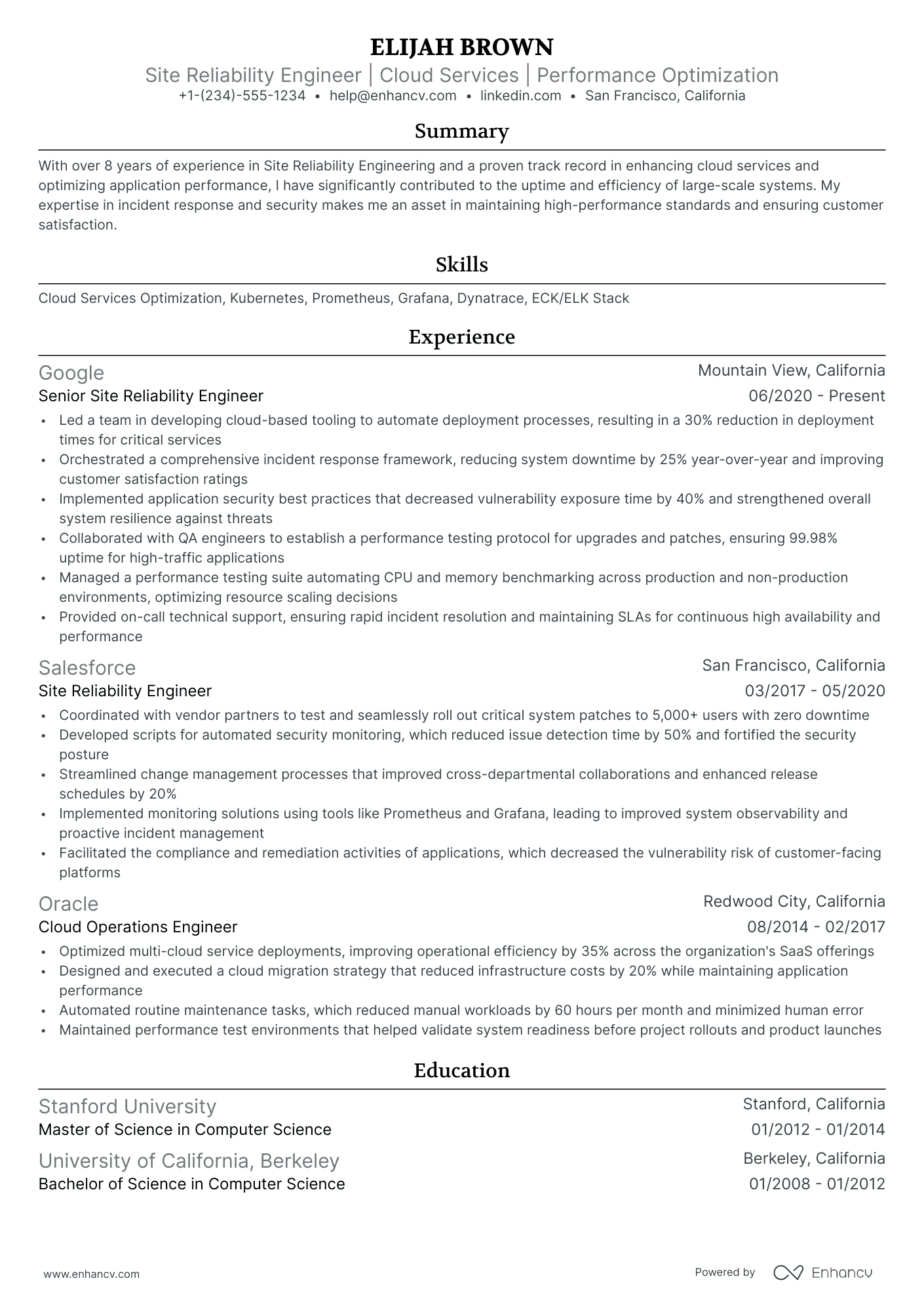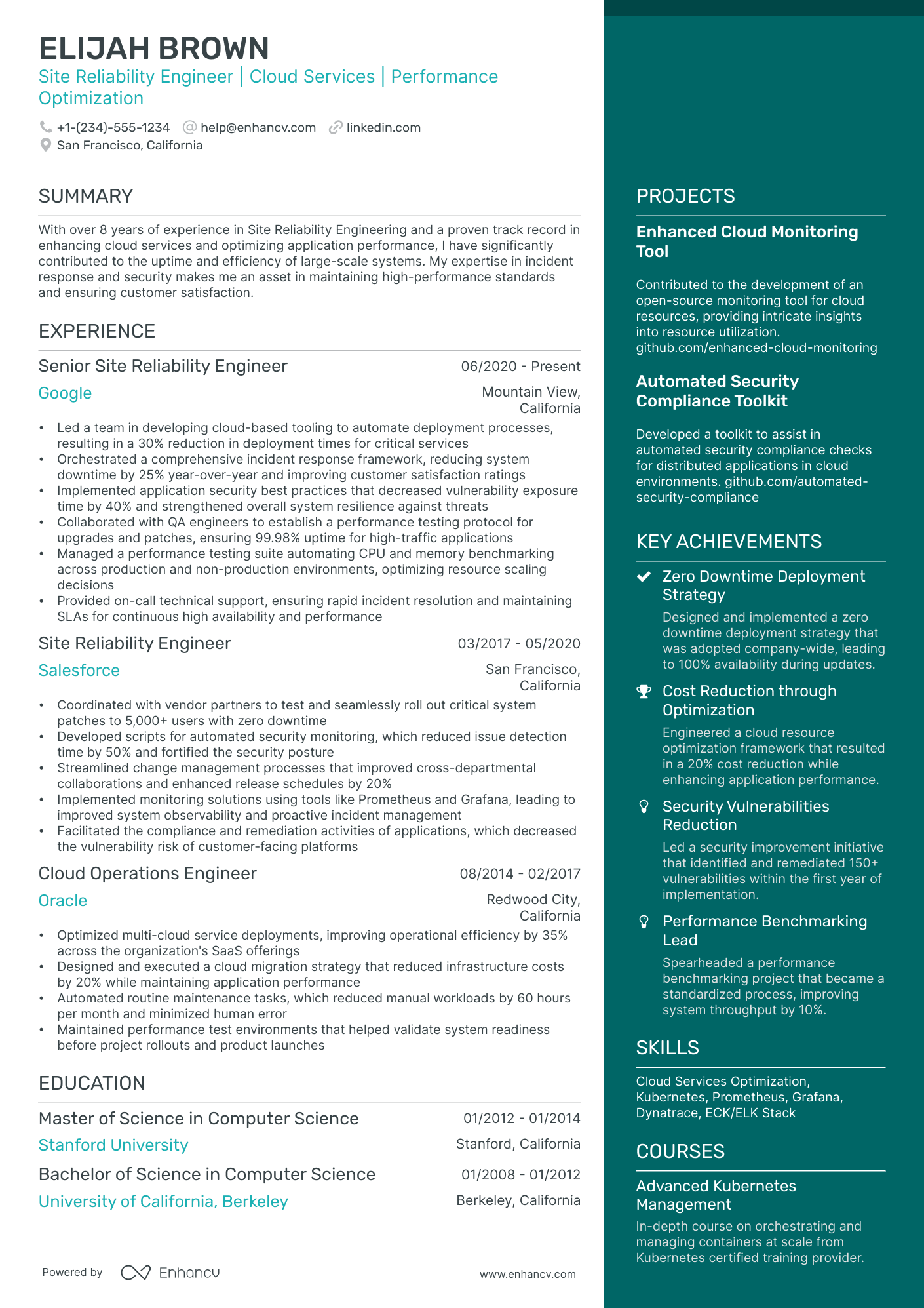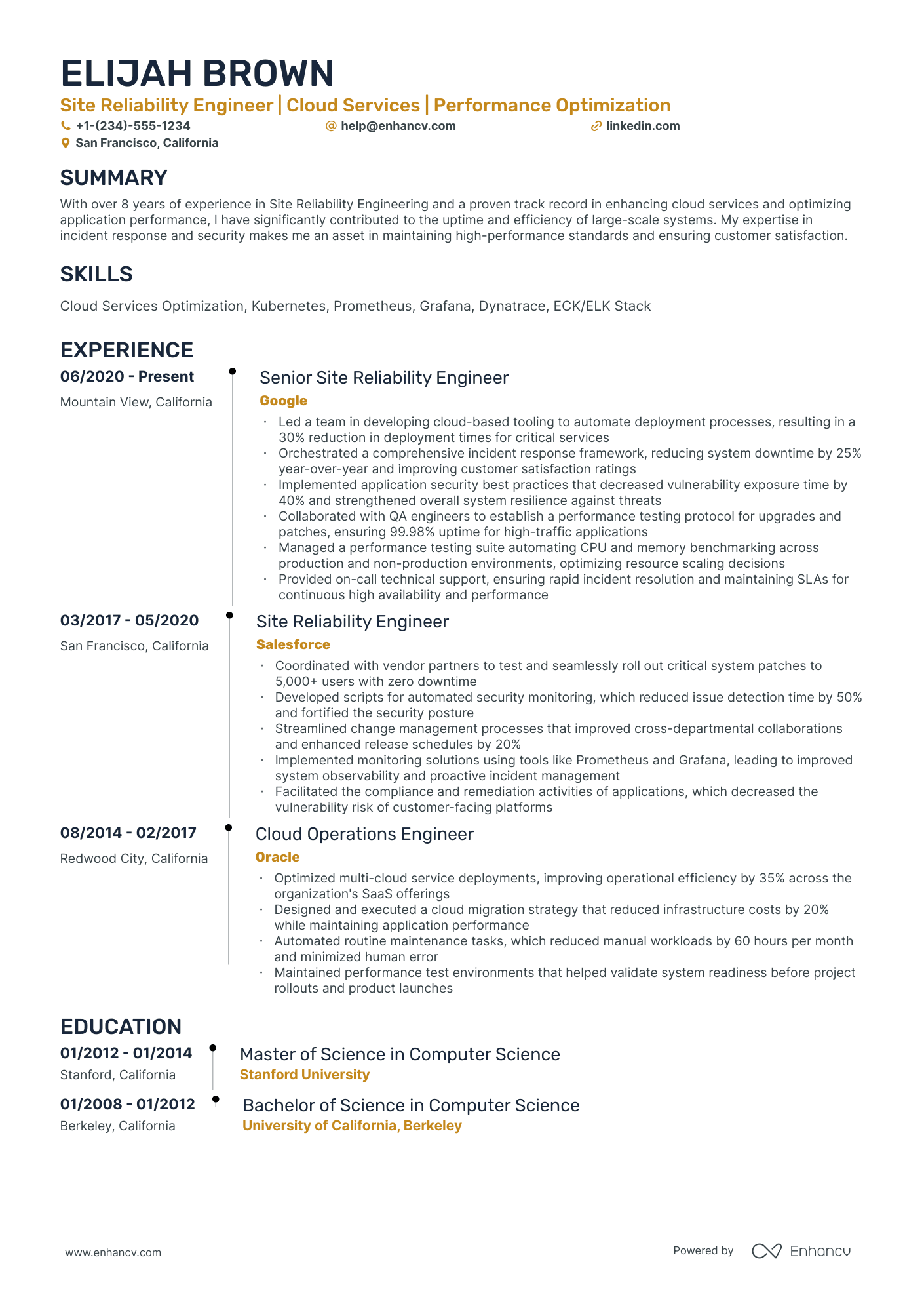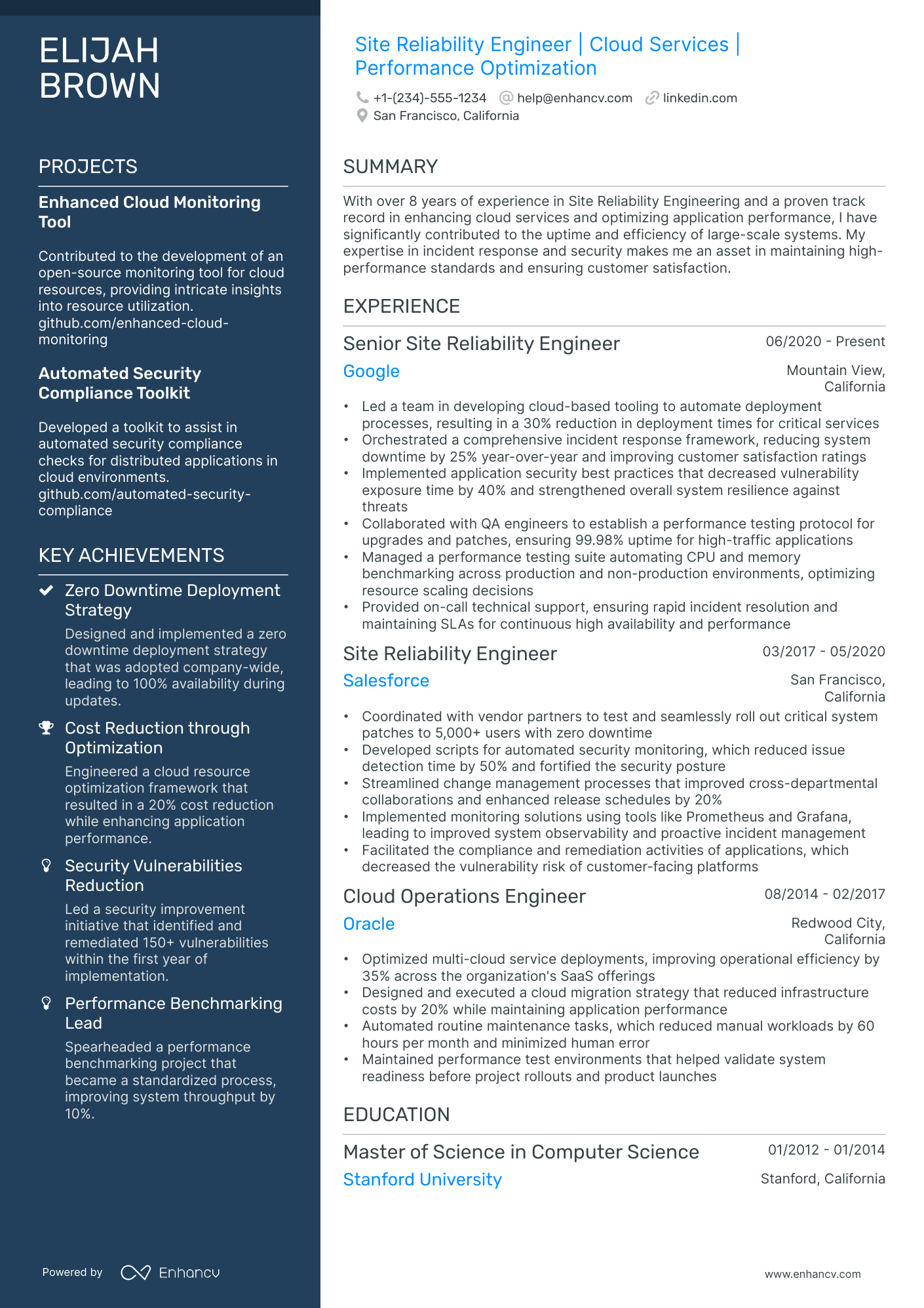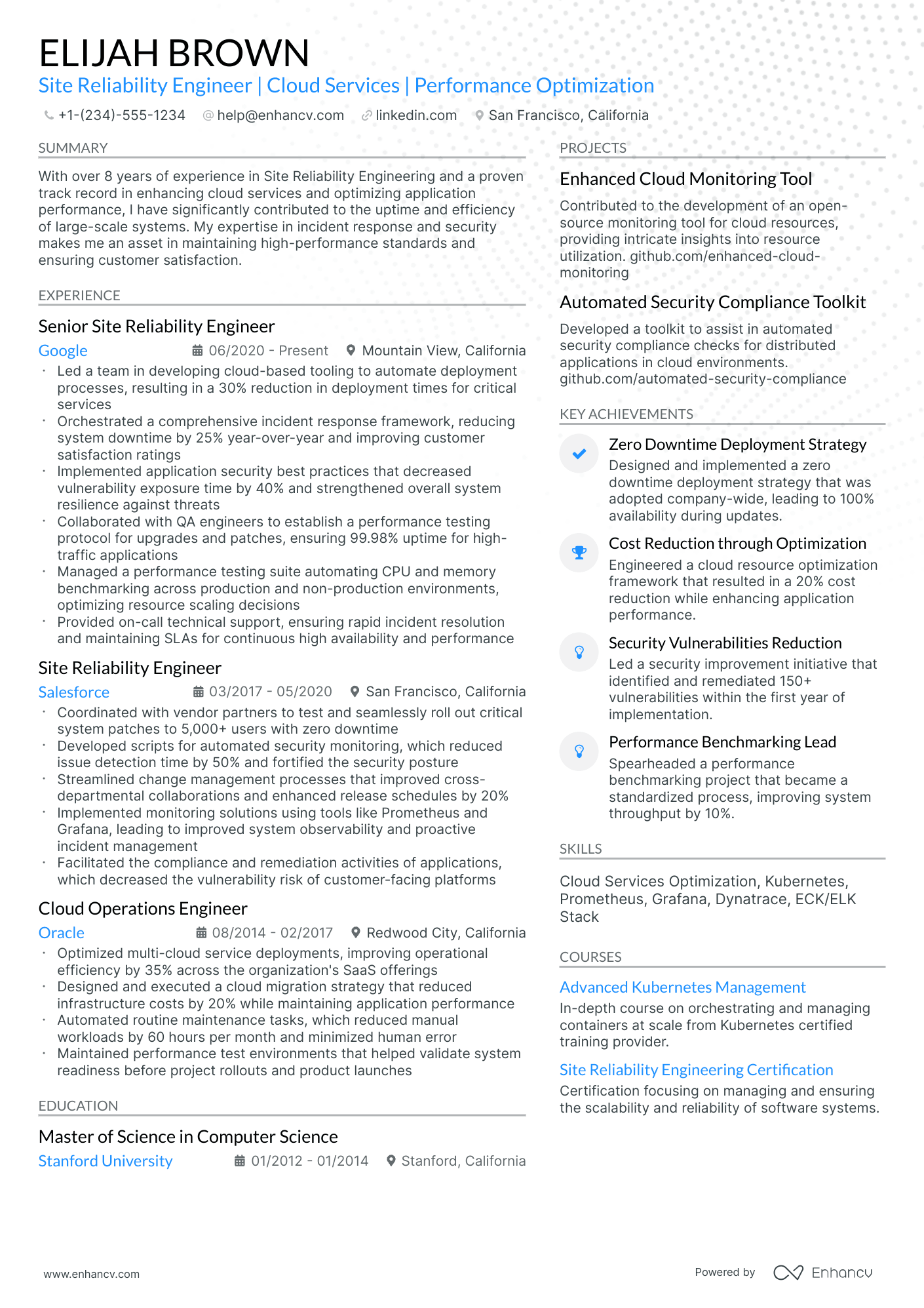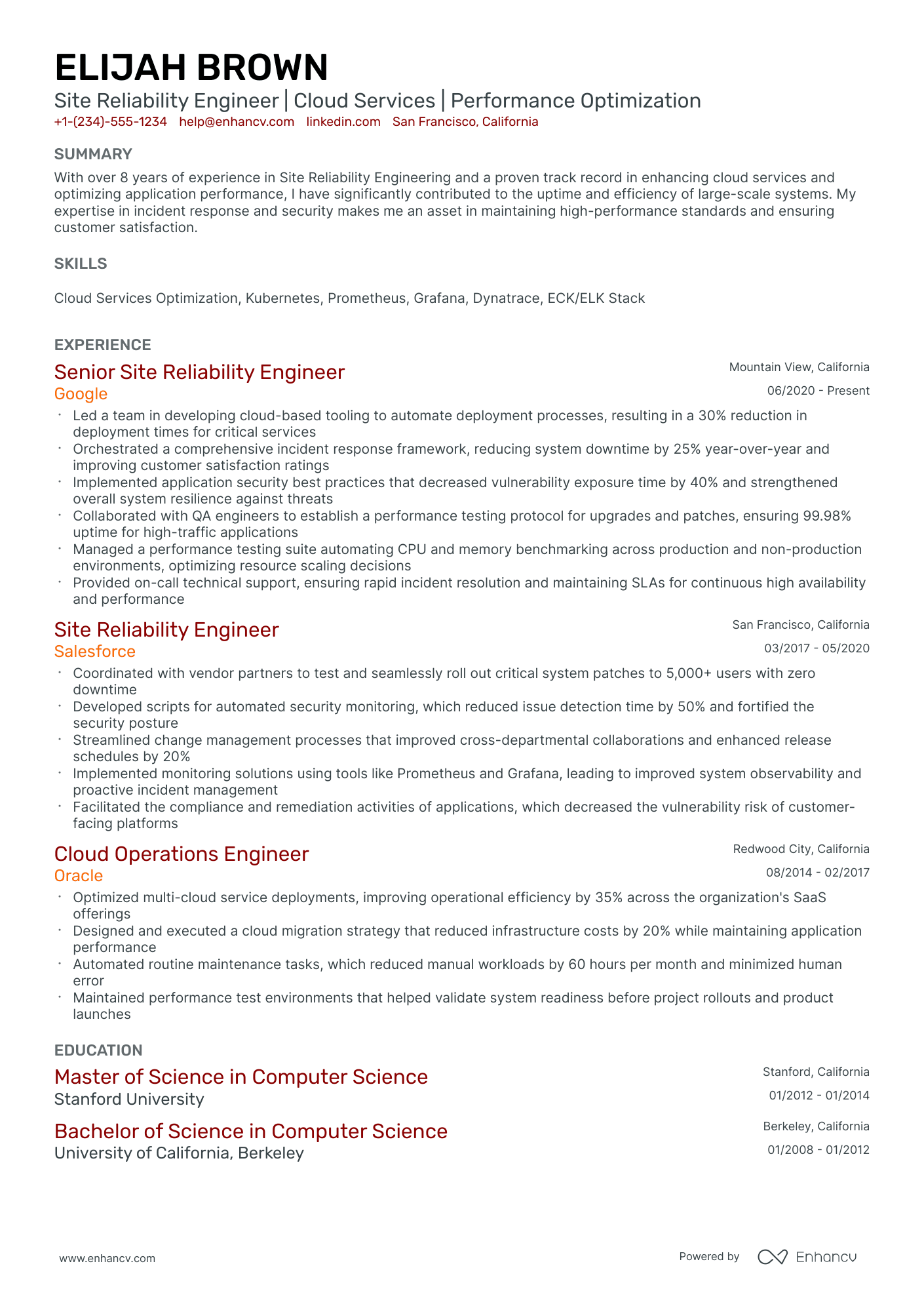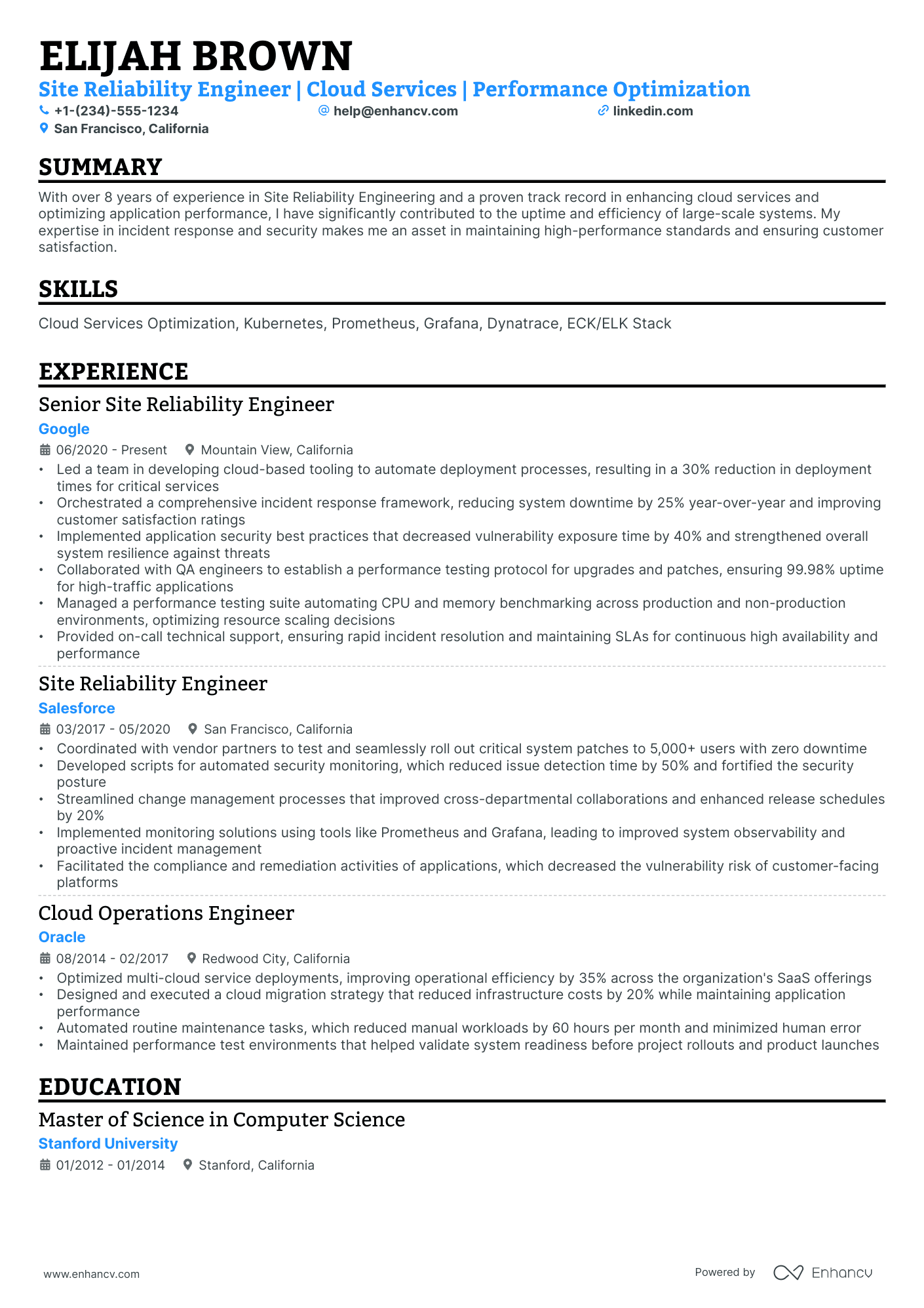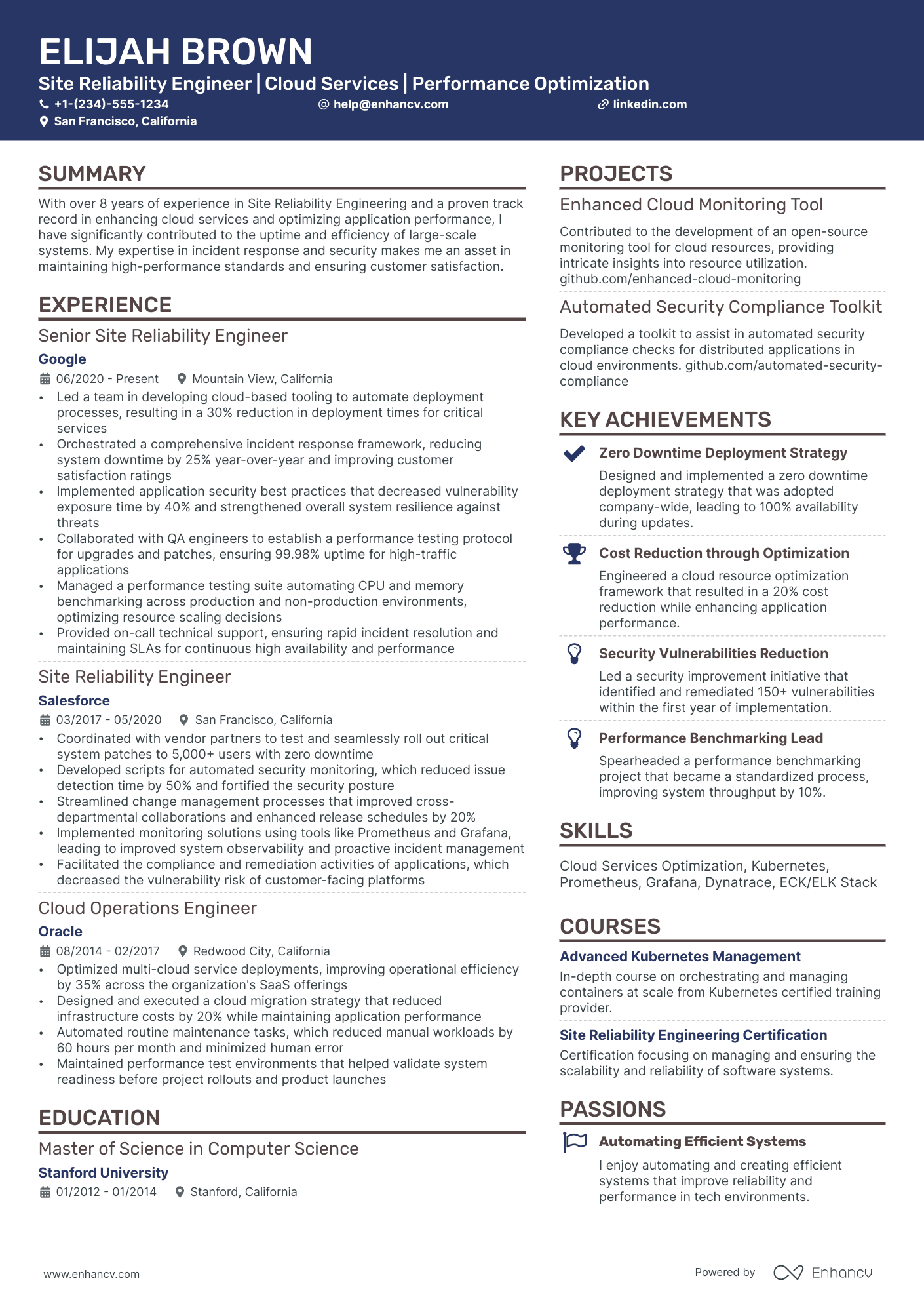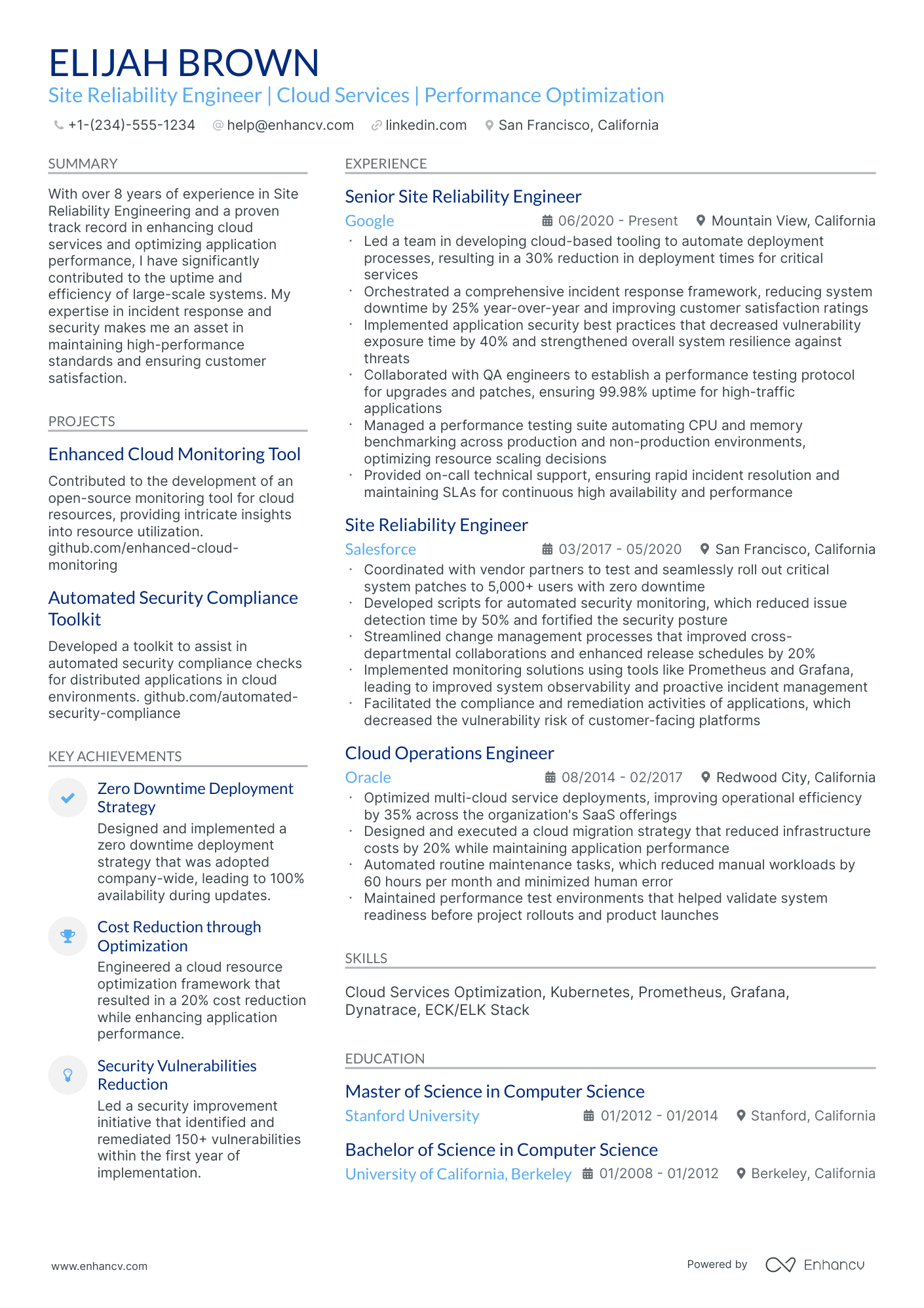As a site reliability engineer, articulating your complex technical experience and skills in a manner that resonates with non-specialist hiring managers can be a daunting resume challenge. Our guide provides clear strategies to effectively communicate the value of your technical contributions, ensuring your resume bridges the gap between specialist know-how and broader business outcomes.
- Sample industry-leading professional resumes for inspiration and site reliability engineer resume-writing know-how.
- Focus recruiters' attention on what matters most - your unique experience, achievements, and skills.
- Write various resume sections to ensure you meet at least 95% of all job requirements.
- Balance your site reliability engineer technical expertise with personality to stand out amongst candidates.
If the site reliability engineer resume isn't the right one for you, take a look at other related guides we have:
Don't stress out over your site reliability engineer resume format
Remember, the elaborate design of your site reliability engineer resume isn't what impresses recruiters most. They are primarily searching for candidates who meet the job requirements. The main aim of your resume should be to clearly and concisely explain why employers should hire you.
Here are four straightforward steps to consider in your site reliability engineer resume design:
- Organize your resume based on experience: Start with your most recent roles. Besides using reverse chronological order, choose jobs relevant to the position you're applying for.
- Include your contact details (and portfolio or LinkedIn link) in your resume's header to ensure recruiters can easily reach you. If considering adding a professional photo, check acceptable practices in different countries first.
- Don't omit essential site reliability engineer resume sections such as the summary or objective, experience, and education. These sections should reflect your career progression and align with job requirements.
- Maintain conciseness in your resume. For those with less than ten years of experience, a one-page format is advisable.
Regarding the format to submit your site reliability engineer resume, PDF is preferable. PDFs are more likely to maintain their formatting when processed through recruitment software or ATS, saving you time in the application process.
When selecting a font for your site reliability engineer resume, consider the following:
- Choose ATS-friendly fonts such as Exo 2, Volkhov, Lato, etc., to keep your resume's content legible;
- All serif and sans-serif fonts are easily readable by ATS;
- While Arial and Times New Roman are common choices, opting for unique typography can help your resume stand out.
Concerned about ATS compatibility with charts and infographics? Our recent study has debunked this and other myths.
Different regions expect different formats – Canadian resumes, for example, may look unique.
Upload & Check Your Resume
Drop your resume here or choose a file. PDF & DOCX only. Max 2MB file size.
PRO TIP
Listing your relevant degrees or certificates on your site reliability engineer resume is a win-win situation. Not only does it hint at your technical capabilities in the industry, but an array of soft skills, like perseverance, adaptability, and motivation.
Fundamental sections for your site reliability engineer resume:
- The header with your name (if your degree or certification is impressive, you can add the title as a follow up to your name), contact details, portfolio link, and headline
- The summary or objective aligning your career and resume achievements with the role
- The experience section to curate neatly organized bullets with your tangible at-work-success
- Skills listed through various sections of your resume and within an exclusive sidebar
- The education and certifications for more credibility and industry-wide expertise
What recruiters want to see on your resume:
- Demonstrated experience with site reliability engineering principles such as Service Level Objectives (SLOs), Service Level Indicators (SLIs), and Error Budgets.
- Proficiency in automation tools and scripting languages (e.g., Python, Bash) for automating repetitive tasks and infrastructure management.
- Experience with cloud services and container orchestration platforms (e.g., AWS, GCP, Azure, Kubernetes) for scalable and reliable deployments.
- Knowledge of monitoring and log aggregation tools (e.g., Prometheus, Grafana, ELK stack) to detect and resolve incidents quickly.
- A strong understanding of incident management, post-mortem culture, and blameless retrospectives to continuously improve system reliability and performance.
Creating your site reliability engineer resume experience to catch recruiters' attention
Remember that for the site reliability engineer role, hiring managers are looking to see how your expertise aligns with their requirements. Here's where your resume experience section can help out. Make sure you:
- Include mainly roles that are relevant to the site reliability engineer job you're applying for;
- Don't go too far back in your experience - recruiters will only care what you did a decade ago if it's really important for the site reliability engineer role;
- Each bullet you include should say what you did, followed by the skills you used and the actual end result of your efforts;
- Quantify each of your achievements with numbers and possibly the overall effect it had on the organization;
- Highlight transferrable skills - or personal skills you've attained thanks to past jobs - that could be applicable within your potential workplace. This would showcase your unique value as a professional.
Formatting the experience section of your resume doesn't have to be an over-the-top deep dive into your whole career. Follow the site reliability engineer resume examples below to see how industry-leading professionals are presenting their experience:
- Led a team of 5 SREs to improve the uptime of mission-critical systems by 99.99% through proactive monitoring and automation at Google Cloud Services.
- Developed a comprehensive disaster recovery plan that reduced system restoration time by 40% under the high-stress scenarios by implementing automated backup solutions.
- Authored internal documentation for best practices in system scalability, leading to a 20% reduction in onboarding time for new engineers and enhancement in cross-team functionality.
- Managed incident response workflows for Amazon Web Services, ensuring rapid mitigation of issues affecting EC2 instances and contributed to a system-wide mean time to recovery (MTTR) improvement of 25%.
- Automated deployment processes using Ansible and Terraform, leading to a 30% reduction in deployment times for new service rollouts.
- Collaborated with development teams to enhance software operability, reducing critical bugs in production environment by 15%.
- Spearheaded the seamless migration of 500+ physical servers to a hybrid cloud environment at IBM, improving the resource utilization rate by 35% and cutting down operational costs.
- Implemented a centralized logging system that improved troubleshooting efficiency by 50%, helping teams to rapidly isolate and rectify system issues.
- Conducted in-depth system performance analysis, which enabled the tuning of systems for a 20% improvement in response times for critical applications.
- Overhauled the monitoring strategies for Microsoft Azure services, which contributed to reducing false positive alerts by 60% and enhancing system reliability.
- Drove a cross-functional project that optimized application deployment strategies, allowing for 50% faster market delivery of new features without compromising on system stability.
- Mentored a team of 10 junior SREs, focusing on upskilling in automation tools such as Chef and Puppet, increasing team productivity by 25%.
- Participated in the on-call rotation at Facebook, handling critical system outages which improved team's incident response by 35% and customer satisfaction rates.
- Contributed to the development of in-house tools for automating error detection, reducing downtime due to undetected errors by 20%.
- Assisted with the rollout of a global Content Delivery Network (CDN) initiative that increased website content load efficiency by 40% in target regions.
- Orchestrated a continuous integration/continuous deployment (CI/CD) pipeline for Twitter's development team, resulting in a 50% acceleration of deployment cycles and improved code quality.
- Designed and implemented proactive monitoring solutions that led to a 45% reduction in severity-1 incidents, significantly enhancing system stability.
- Played a key role in the Kubernetes cluster management, optimizing application scaling and load balancing, which led to a 30% cost-saving on compute resources.
- Architected a full-stack solution for real-time analytics at Netflix, improving data delivery throughput by 70% and assisting in data-informed decision-making for feature releases.
- Enhanced the Kafka streaming platform to handle a surge in data volume by 100%, ensuring zero downtime during peak traffic hours.
- Managed a large-scale deployment of microservices that increased deployment frequency by 80% and reduced rollback instances due to improved service isolation.
- Engineered a robust observability framework for Dropbox using Prometheus and Grafana, simplifying diagnostics and enabling a 33% quicker issue resolution.
- Developed a self-service portal for resource provisioning that drastically reduced manual efforts by 50% and empowered developers with quicker access to development environments.
- Facilitated a company-wide migration to containerized environments using Docker, which resulted in a 25% enhancement in application performance and scalability.
The following content includes information from "O*NET OnLine" by the U.S. Department of Labor, Employment and Training Administration (USDOL/ETA). Used under the CC BY 4.0 license. The data represents the top responsibilities present on the task lists for site reliability engineer professionals.
Top Responsibilities for Site Reliability Engineer:
- Study product characteristics or customer requirements to determine validation objectives and standards.
- Analyze validation test data to determine whether systems or processes have met validation criteria or to identify root causes of production problems.
- Develop validation master plans, process flow diagrams, test cases, or standard operating procedures.
- Prepare detailed reports or design statements, based on results of validation and qualification tests or reviews of procedures and protocols.
- Maintain validation test equipment.
- Conduct validation or qualification tests of new or existing processes, equipment, or software in accordance with internal protocols or external standards.
- Communicate with regulatory agencies regarding compliance documentation or validation results.
- Prepare, maintain, or review validation and compliance documentation, such as engineering change notices, schematics, or protocols.
- Recommend resolution of identified deviations from established product or process standards.
- Design validation study features, such as sampling, testing, or analytical methodologies.
Quantifying impact on your resume
- Highlight the number of incidents you've resolved to show your problem-solving efficiency.
- Specify the size of infrastructure you have managed to demonstrate the scale of your capabilities.
- Mention the percentage reduction in downtime you achieved to underscore your effectiveness in increasing reliability.
- Include the number of automation scripts or tools you've developed to quantify your contribution to operational efficiency.
- Detail the percentage improvement in system performance metrics due to optimizations you've implemented.
- Note the growth in service capacity or scalability as a result of your work to illustrate your impact on service expansion.
- List the amount of cost savings achieved through your efforts to show your ability to drive financial efficiency.
- State the number of cross-departmental collaborations you've led to highlight your teamwork and influence across the organization.
Action verbs for your site reliability engineer resume
Four quick steps for candidates with no resume experience
Those with less or no relevant experience could also make a good impression on recruiters by:
- Taking the time to actually understand what matters most to the role and featuring this within key sections of their resume
- Investing resume space into defining what makes them a valuable candidate with transferrable skills and personality
- Using the resume objective to showcase their personal vision for growth within the company
- Heavily featuring their technical alignment with relevant certifications, education, and skills.
Remember that your resume is about aligning your profile to that of the ideal candidate.
The more prominently you can demonstrate how you answer job requirements, the more likely you'd be called in for an interview.
Recommended reads:
PRO TIP
List your educational qualifications and certifications in reverse chronological order.
Popular site reliability engineer hard skills and soft skills for your resume
Apart from assessing your professional expertise, recruiters are on the lookout for whether your skills align with the job.
Your profile would thus be assessed in regard to your:
- Hard or technical skills - your ability to perform on the job using particular technologies or software
- Soft skills - how you adapt, communicate, and thrive in different environments.
Both types of skills - hard and soft skills - are important for your resume, so make sure to create a dedicated skills section that:
- Lists up to five or six skills that align with the job advert.
- Integrates vital keywords for the industry, but also reflects on your personal strengths.
- Builds up further your skills with an achievements section within which you explain what you've achieved thanks to using the particular skill.
- Aims to always quantify in some way how you've used the skill, as it's not enough to just list it.
What are the most sought out hard and soft skills for site reliability engineer roles?
Check out the industry's top choices with our two dedicated lists below:
Top skills for your site reliability engineer resume:
Linux/Unix Administration
Scripting and Automation (e.g., Shell, Python, Ruby)
Cloud Services (e.g., AWS, GCP, Azure)
Containerization and Orchestration (e.g., Docker, Kubernetes)
Configuration Management Tools (e.g., Ansible, Puppet, Chef)
Continuous Integration/Continuous Deployment (CI/CD)
Monitoring and Alerting Tools (e.g., Prometheus, Grafana, Splunk)
Networking Principles and Protocols (e.g., TCP/IP, HTTP/S)
Version Control Systems (e.g., Git, SVN)
Database Administration (e.g., SQL, NoSQL)
Problem-Solving
Communication
Teamwork
Attention to Detail
Adaptability
Proactivity
Stress Management
Critical Thinking
Time Management
Customer Service
Next, you will find information on the top technologies for site reliability engineer professonals from "O*NET OnLine" by the U.S. Department of Labor, Employment and Training Administration (USDOL/ETA). Used under the CC BY 4.0 license.
Top technologies for Site Reliability Engineer’s resume:
- Apache Kafka
- Apache Maven
- Microsoft PowerPoint
- Minitab
- The MathWorks MATLAB
PRO TIP
If you failed to obtain one of the certificates, as listed in the requirements, but decide to include it on your resume, make sure to include a note somewhere that you have the "relevant training, but are planning to re-take the exams". Support this statement with the actual date you're planning to be re-examined. Always be honest on your resume.
The basics of your site reliability engineer resume certifications and education sections
Improve the education and certification sections of your site reliability engineer resume by:
- Dedicating more prominent space to certificates that are more recent and have helped you update your skill set
- Keeping all the information you list to the basics: certificate/degree name, institution, and graduation dates
- Writing supplementary information in the details of your certification or education section, only if you lack experience or want to show further skill alignment
- Including your credential or license number, only if the information is valid to your application or certification
Within site reliability engineer job adverts, relevant education, and certification are always listed within the key prerequisite for the role.
Ensure you meet all job requirements with some of the leading certificates in the industry:
The top 5 certifications for your site reliability engineer resume:
- Google Cloud Professional site reliability engineer (Professional SRE) - Google
- Certified Kubernetes Administrator (CKA) - Cloud Native Computing Foundation
- Microsoft Certified: Azure Administrator Associate (AZ-104) - Microsoft
- Amazon Web Services (AWS) Certified SysOps Administrator - Associate - Amazon
- Red Hat Certified Engineer (RHCE) - Red Hat
The content below includes information from "O*NET OnLine" by the U.S. Department of Labor, Employment and Training Administration (USDOL/ETA). Used under the CC BY 4.0 license. The data represents the top associations for site reliability engineer professionals.
Top US associations for a Site Reliability Engineer professional
- Accreditation Board for Engineering and Technology
- American Institute of Aeronautics and Astronautics
- American Productivity and Quality Center
- American Society for Engineering Education
- American Society for Quality
PRO TIP
Always remember that your site reliability engineer certifications can be quantified across different resume sections, like your experience, summary, or objective. For example, you could include concise details within the expertise bullets of how the specific certificate has improved your on-the-job performance.
Recommended reads:
Should you write a resume summary or an objective?
No need to research social media or ask ChatGPT to find out if the summary or objective is right for your site reliability engineer resume.
- Experienced candidates always tend to go for resume summaries. The summary is a three to five sentence long paragraph that narrates your career highlights and aligns your experience to the role. In it you can add your top skills and career achievements that are most impressive.
- Junior professionals or those making a career change, should write a resume objective. These shouldn't be longer than five sentences and should detail your career goals . Basically, how you see yourself growing in the current position and how would your experience or skill set could help out your potential employers.
Think of both the resume summary and objective as your opportunity to put your best foot forward - from the get go - answering job requirements with skills.
Use the below real-world site reliability engineer professional statements as inspiration for writing your resume summary or objective.
Resume summaries for a site reliability engineer job
- With a decade of dedicated experience in maintaining large-scale, high-availability systems, I have proven my ability as a site reliability engineer at TechCorp. My main achievements include a 99.99% uptime record, architecting robust monitoring solutions, and spearheading a cross-departmental incident response protocol that reduced downtime by 40%.
- As an adept software developer with 5 years at StartDev transitioning into site reliability, I bring deep expertise in coding and system design. Major success included developing a custom continuous integration tool that enhanced deployment efficiency. Keen to leverage software development experience to ensure unparalleled system reliability and operational excellence.
- Former network engineer with eight years of experience, seeking to leverage my vast knowledge of network architecture and proactive system monitoring in a site reliability engineer capacity. Successfully led a team to redesign network infrastructure, improving system resilience by 25%, and ready to apply a structured approach to optimizing uptime and system performance at a large scale.
- An accomplished cybersecurity analyst for over 6 years, I aspire to incorporate this experience into site reliability engineering. Instrumental in creating and maintaining secure system frameworks, I anticipate employing a security-first mindset to enhance system dependability and preemptively address vulnerabilities impacting system reliability.
- Aiming to embark on a career in site reliability engineering, I am passionate about mastering cutting-edge technologies and applying analytical skills to solve complex system issues. Motivated to learn rapidly, contribute to sustained system uptime, and ensure seamless user experiences even with no prior direct experience in the field.
- As a fresh graduate with a degree in computer science and internships focused on software development and system administration, I am eager to contribute a strong fundamental understanding of coding and network protocols to a site reliability engineer role. My objective is to grow within the field, ensuring robust and scalable system solutions while continuously enhancing my skill set.
Optimize your resume summary and objective for ATS
Drop your resume here or choose a file.
PDF & DOCX only. Max 2MB file size.
Average salary info by state in the US for site reliability engineer professionals
Local salary info for Site Reliability Engineer.” Source: My Next Move, National Center for O*NET Development. Accessed 10/15/2024
| State | Average Salary (in USD) |
|---|---|
| US National Average | $99,380 |
| California (CA) | $111,770 |
| Texas (TX) | $102,020 |
| Florida (FL) | $100,010 |
| New York (NY) | $99,110 |
| Pennsylvania (PA) | $84,530 |
| Illinois (IL) | $99,660 |
| Ohio (OH) | $96,500 |
| Georgia (GA) | $95,930 |
| North Carolina (NC) | $94,040 |
| Michigan (MI) | $98,340 |
Other relevant sections for your site reliability engineer resume
Apart from the standard site reliability engineer resume sections listed in this guide, you have the opportunity to get creative with building your profile. Select additional resume sections that you deem align with the role, department, or company culture. Good choices for your site reliability engineer resume include:
- Language skills - always ensure that you have qualified each language you speak according to relevant frameworks;
- Hobbies - you could share more about your favorite books, how you spend your time, etc. ;
- Volunteering - to highlight the causes you care about;
- Awards - for your most prominent site reliability engineer professional accolades and achievements.
Make sure that these sections don't take too much away from your experience, but instead build up your site reliability engineer professional profile.
Key takeaways
- Ensure your site reliability engineer resume uses a simple, easy-to-read format that reflects upon your experience and aligns with the role;
- Be specific within the top one-third of your resume (header and summary or objective) to pinpoint what makes you the ideal candidate for the site reliability engineer role;
- Curate information that is tailored to the job by detailing skills, achievements, and actual outcomes of your efforts;
- List your certifications and technical capabilities to demonstrate your aptitude with specific software and technologies;
- The sections you decide on including on your site reliability engineer should pinpoint your professional expertise and personality.
